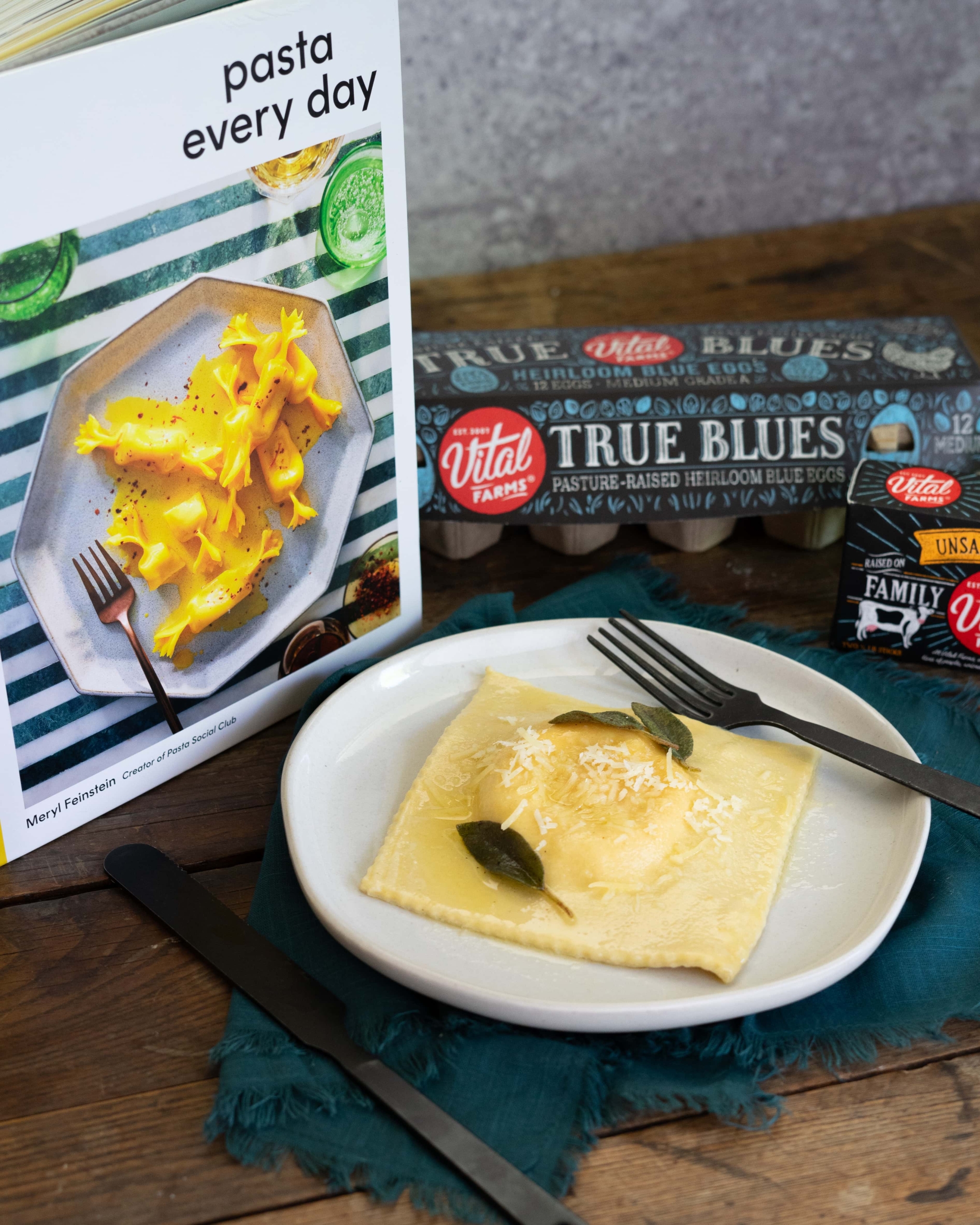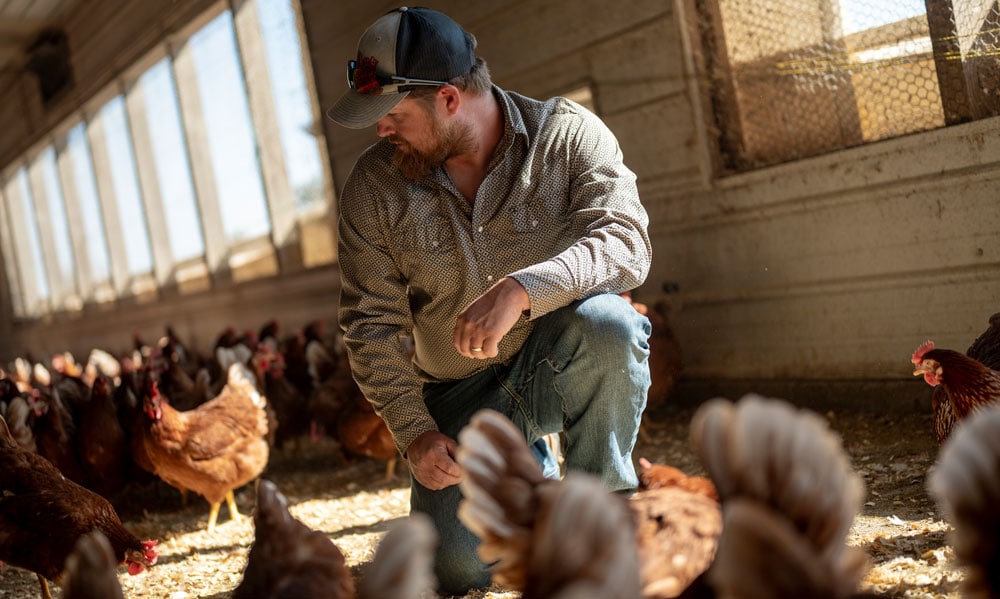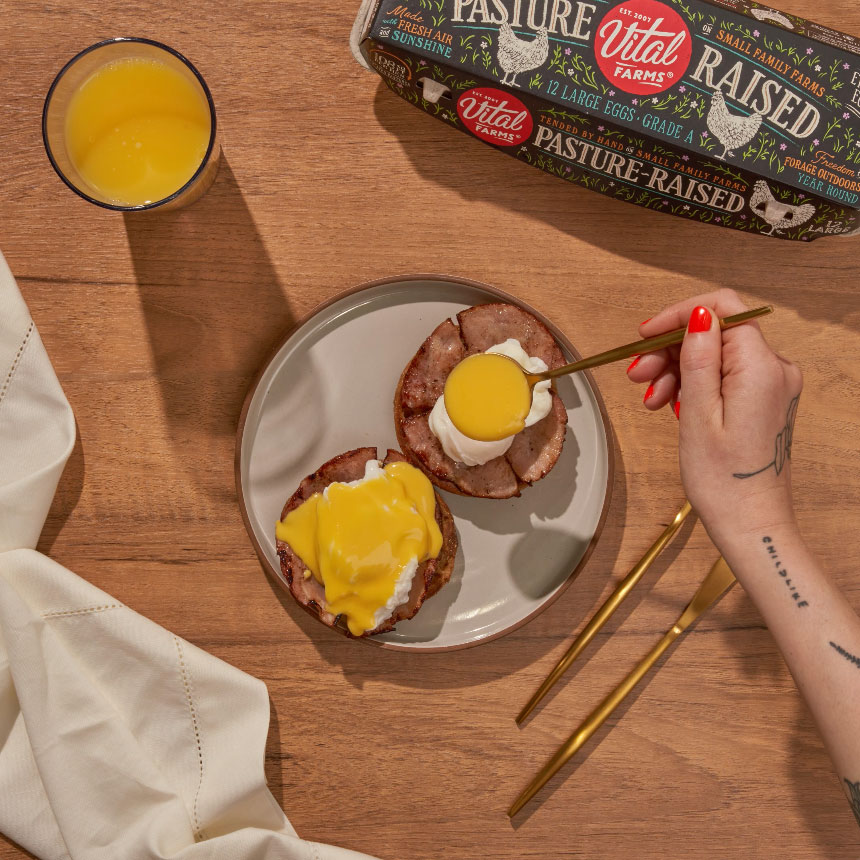Egg Yolk Raviolo
Meryl Feinstein’s motto is “Make ravioli, make friends.” As a pasta aficionado, creator of @pastasocialclub, and longtime friend of Vital Farms, we’re sharing a recipe adapted from her new cookbook, Pasta Every Day, so you too can make ravioli and friends. In 1974, chefs Nino Bergese and Valentino Marcattilii of the Michelin-starred Ristorante San Domenico in Imola (near Bologna) changed ravioli forever. Encased within delicate sheets of egg pasta and a towering nest of spinach and ricotta was an egg yolk. With one satisfying cut, the humble yolk became unctuous liquid gold, pooling alongside the cheesy filling to create its own decadent sauce. The dish was, of course, finished with a shower of freshly shaved truffles.These ravioli are more common today, but they’re no less spectacular. Try them for Valentine’s Day, a birthday, or another special occasion—or, an average Sunday. Serve them in a simple butter sauce to keep the focus on the yolk

Equipment
- A work surface, preferably wooden
- Pasta machine
- Fluted pasta cutter, pasta wheel, sharp knife, or large cookie cutter
- Small bowl or spray bottle of water
Ingredients
Standard Egg Pasta Dough
- 350 grams 2 1/4 cups 00 or all-purpose flour
- 50 grams 5 tablespoons semolina flour
- 225 grams Vital Farms Eggs about 4 large plus 1 to 2 egg yolks
Whipped Ricotta Filling
- 16 ounces 450 grams full-fat ricotta, drained if needed
- Kosher salt and freshly ground black pepper
- 2 ounces 55 grams finely grated Parmigiano-Reggiao
- Egg Yolks for filling
Butter Sage Sauce
- 3/4 cup 170 grams, 1 1/2 sticks Vital Farms Unsalted Butter
- 16 fresh sage leaves or more if you’d like
- Kosher salt
- Freshly grated Parmigiano-Reggiano for serving
Instructions
- Make the pasta. Keep the flour in the bowl or turn onto a work surface. Make a wide well in the center with your fist, forming a wall of flour tall enough on all sides to contain the liquid.
- Using a fork, gradually incorporate a portion of the flour, a couple of teaspoons or so at a time, from the inner rim of the well into the liquid in a circular motion until a thick, custardy batter forms. Incorporate the remaining flour by pulling, folding, and pressing the flour into the center until it becomes a shaggy ball. Knead vigorously. After about 5 minutes, cover the dough tightly in plastic wrap. Let rest for 5-10 minutes. Then continue to knead the dough until it’s smooth and firm.
- Make the filling by combining cheeses and a generous pinch of salt and pepper to the bowl of a food processor. Pulse until very smooth, 30 to 60 seconds, scraping down the side of the bowl as needed.3. Make the filling by combining cheeses and a generous pinch of salt and pepper to the bowl of a food processor. Pulse until very smooth, 30 to 60 seconds, scraping down the side of the bowl as needed.
- Assemble pasta. Use a pasta machine to roll the dough into very thin pasta sheets. Trim into 6-inch squares. Use a piping bag to pipe the filling “nest” that holds the yolk in place (a large zip-top bag with a corner snipped off will work in a pinch). Cover and seal around the filling. Trim the edges using a pasta wheel. Place on a sheet pan dusted in semolina.
- In a large sauté pan or skillet, melt the butter over medium heat. Add the sage and fry until crisp and dark around the edges, swirling the pan often to coat the leaves in the butter, about 3 minutes. Remove from the heat and transfer the sage to a paper towel–lined plate.
- Cook your pasta of choice to your liking. When the pasta is almost done, return the butter to medium heat. Scoop out ¾ cup pasta cooking water and add it to the butter. Whisk or stir the sauce constantly until emulsified.
- Simmer the sauce until slightly thickened, about 2 minutes. Transfer the pasta to a serving platter or bowl and pour the sauce on top, making sure all the pasta is coated.
- Serve topped with grated Parmigiano-Reggiano and the fried sage.
- The key to fully cooked pasta with a still-runny egg yolk is very thin pasta sheets.
- Use a thick, creamy filling that can stand tall; a very soft, runny filling won’t encase the yolk properly. I especially recommend the black pepper and pecorino filling, the mushroom filling, or, of course, the spinach and ricotta filling to honor tradition.
- To separate the eggs, crack them into a bowl, then gently scoop up each yolk with my hands, passing it back and forth between them to remove all of the white. You can do them all at once or one at a time, but make sure to place each yolk in its own small bowl or cup.
- These ravioli are decadent, so two per person is usually plenty. Use the leftover dough and filling as you please: Make “classic” ravioli or cut the dough into any pasta shape and cook it, then thin out your filling with some pasta water to make a creamy sauce.
- It’s best to cook these as soon as you’re done making them, but they’ll keep on a semolina-dusted sheet pan, uncovered, in the refrigerator, for up to 2 hours.
- The leftover egg whites can be stored in an airtight container in the refrigerator for 2 to 3 days. Use them in frittatas or omelets, or shake them into cocktails.




